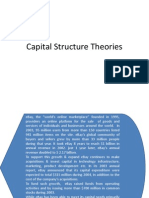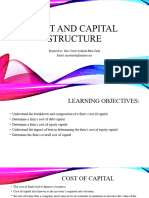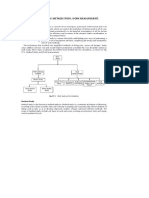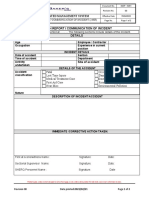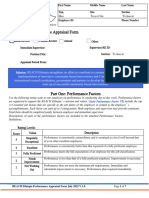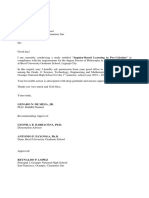0 ratings0% found this document useful (0 votes)
29 viewsAccording To Gerestenbeg, "Capital Structure of
According To Gerestenbeg, "Capital Structure of
Uploaded by
Anmol GuptaThe document discusses capital structure theories including:
1. The Net Income Approach developed by Durand, which states that capital structure decisions are relevant to valuation and increased debt increases shareholder earnings.
2. The Net Operating Income Approach, also developed by Durand, which argues the opposite - that capital structure decisions are irrelevant to valuation and increased debt increases shareholder risk.
3. Other theories discussed include the Traditional Approach and Modigliani and Miller Approach. The document provides formulas for calculating firm value, equity value, and weighted average cost of capital under the Net Income and Net Operating Income approaches.
Copyright:
© All Rights Reserved
Available Formats
Download as PPTX, PDF, TXT or read online from Scribd
According To Gerestenbeg, "Capital Structure of
According To Gerestenbeg, "Capital Structure of
Uploaded by
Anmol Gupta0 ratings0% found this document useful (0 votes)
29 views11 pagesThe document discusses capital structure theories including:
1. The Net Income Approach developed by Durand, which states that capital structure decisions are relevant to valuation and increased debt increases shareholder earnings.
2. The Net Operating Income Approach, also developed by Durand, which argues the opposite - that capital structure decisions are irrelevant to valuation and increased debt increases shareholder risk.
3. Other theories discussed include the Traditional Approach and Modigliani and Miller Approach. The document provides formulas for calculating firm value, equity value, and weighted average cost of capital under the Net Income and Net Operating Income approaches.
Original Description:
Financial Mgmt
Original Title
Ppt
Copyright
© © All Rights Reserved
Available Formats
PPTX, PDF, TXT or read online from Scribd
Share this document
Did you find this document useful?
Is this content inappropriate?
The document discusses capital structure theories including:
1. The Net Income Approach developed by Durand, which states that capital structure decisions are relevant to valuation and increased debt increases shareholder earnings.
2. The Net Operating Income Approach, also developed by Durand, which argues the opposite - that capital structure decisions are irrelevant to valuation and increased debt increases shareholder risk.
3. Other theories discussed include the Traditional Approach and Modigliani and Miller Approach. The document provides formulas for calculating firm value, equity value, and weighted average cost of capital under the Net Income and Net Operating Income approaches.
Copyright:
© All Rights Reserved
Available Formats
Download as PPTX, PDF, TXT or read online from Scribd
Download as pptx, pdf, or txt
0 ratings0% found this document useful (0 votes)
29 views11 pagesAccording To Gerestenbeg, "Capital Structure of
According To Gerestenbeg, "Capital Structure of
Uploaded by
Anmol GuptaThe document discusses capital structure theories including:
1. The Net Income Approach developed by Durand, which states that capital structure decisions are relevant to valuation and increased debt increases shareholder earnings.
2. The Net Operating Income Approach, also developed by Durand, which argues the opposite - that capital structure decisions are irrelevant to valuation and increased debt increases shareholder risk.
3. Other theories discussed include the Traditional Approach and Modigliani and Miller Approach. The document provides formulas for calculating firm value, equity value, and weighted average cost of capital under the Net Income and Net Operating Income approaches.
Copyright:
© All Rights Reserved
Available Formats
Download as PPTX, PDF, TXT or read online from Scribd
Download as pptx, pdf, or txt
You are on page 1of 11
CAPITAL STRUCTURE
According to Gerestenbeg, “Capital structure of
a company refers to the composition or make-up
of its capitalisation and it includes all long-term
capital resources viz : loans, reserves, shares and
books.”
THEORIES OF CAPITAL
STRUCTURE
• The main contributors to the theories are Durand, Ezra, Solomon,
Modigliani and Miller.
• The important theories are:
1. Net Income Approach.
2. Net Operating Income Approach.
3. The Traditional Approach.
4. Modigliani and Miller Approach.
1. Net Income Approach:
This approach has been developed by Durand. The main findings
are:
Capital structure decisions are relevant to the valuation of the
firm.
Increased use of debt will increase the shareholders’ earning.
ASSUMPTIONS
• Capital structure consists of debt and equity.
• Cost of debt is less than cost of equity (i.e. Kd<Ke).
• The use of debt content does not change the risk perception of
investors.
CALCULATION OF THE VALUE OF THE FIRM
• According to Net Income Approach the value of the firm can be
ascertained as follows:
• V = S+ D
where,
V= Value of the firm
S= Market value of equity=Earnings available for equity shareholders/
Equity capitalisation rate.
D= Market value of debt.
CALCULATION OF OVERALL COST
OF CAPITAL
• According to Net Income Approach the overall cost of capital or
expected rate of return (WACC) can be calculated as follows:
• (Ko) = EBIT X 100
v
where,
Ko= Overall cost of capital
EBIT= Earnings before interest and tax
V= Value of firm
2. NET OPERATING INCOME
(NOI) APPROACH
Another theory of capital structure, suggested but Durand, is the Net
Operating Income approach. This approach is simply opposite to the
Net Income approach.
• The main findings are:
Capital structure decisions are irrelevant to the valuation of the
firm:.
Increased use of debt will increase the financial risk of the
shareholders.
ASSUMPTIONS
(a) The market capitalises the value of firm as a whole.
(b) Cost of debt (Kd) is constant.
(c) Increases use of debt increases the financial risk of equity shareholder
which, in turn, raises the cost of equity (Ke).
(d) Overall cost of capital (Ko) remains constant for all levels of debt equ
mix.
(e) There is no corporate income tax.
VARIOUS CALCULATION UNDER NET OPERATING INCOME
APPROACH ARE EXPLAINED BELOW:
1. Value of Firm (V): 2. Market Value of Equity (S):
V = EBIT S =V–D
Ko where, S= Market value of equity
where,
V= Value of firm
V = Value of firm
D = Market value of debt.
Ko= Overall Cost of Capital
EBIT= Earnings Before Interest & taxes
NET OPERATING INCOME
V/S NET INCOME
APPROACH
Net operating income Approach Net income Approach
• No relevance in capital structure. • Relevance in capital structure.
• Degree of leverage is irrelevant to cost of • Change in degree of leverage will
capital (assumes). change WACC (assumes).
• It has constant cost of capital. • No taxes.
• Equity value is residual (derived by • Cost of debt is less than cost of equity.
subtracting value of debt from value of firm). • Change in debt will not change
• Changes perception of investor with increase perception of investors.
in debt.
THANK YOU !!!
You might also like
- Benchmark - Mobile App Planning and Design MTDocument14 pagesBenchmark - Mobile App Planning and Design MTMarisa TolbertNo ratings yet
- Cost of CapitalDocument74 pagesCost of CapitalHarnitNo ratings yet
- Erotic FacultiesDocument246 pagesErotic FacultiesAltaica67% (3)
- Quibuyen S A Nation Aborted Summary NotesDocument5 pagesQuibuyen S A Nation Aborted Summary NotesJiyuNo ratings yet
- So Mote It Be! - Christian BernardDocument100 pagesSo Mote It Be! - Christian BernardGreg100% (2)
- New CapitalDocument30 pagesNew CapitalVeeresh Madival VmNo ratings yet
- NI Approach MainDocument9 pagesNI Approach MainRevati ShindeNo ratings yet
- Capital Structure .PPTX - Sessions 11Document32 pagesCapital Structure .PPTX - Sessions 11Jerry DjondoNo ratings yet
- Capital StructureDocument40 pagesCapital StructureUdit TripathiNo ratings yet
- Capital StructureDocument44 pagesCapital Structure26155152No ratings yet
- Capital StructureDocument50 pagesCapital StructureAtri RaychaudhuriNo ratings yet
- Financial Management - Session 2Document25 pagesFinancial Management - Session 2amishi.22019No ratings yet
- Capitalstructureplanning 1Document51 pagesCapitalstructureplanning 1PreethamNo ratings yet
- Capital Structure Part 1Document23 pagesCapital Structure Part 1dshivansh195No ratings yet
- Capital Structure: By: Anuja RastogiDocument19 pagesCapital Structure: By: Anuja RastogiMansi SainiNo ratings yet
- Unit II.2 Capital Structure MainDocument52 pagesUnit II.2 Capital Structure MainDhruv singhNo ratings yet
- Capital Structure: Graham, Steve, Rob Brown Seventh EditionDocument33 pagesCapital Structure: Graham, Steve, Rob Brown Seventh EditionHibaaq AxmedNo ratings yet
- Capital StructureDocument41 pagesCapital StructureRAJASHRI SNo ratings yet
- Capital StructureDocument28 pagesCapital Structureyaatin dawarNo ratings yet
- CAPITAL STRUCTURE Risk Management LectureDocument41 pagesCAPITAL STRUCTURE Risk Management LectureJunior LemeNo ratings yet
- Format Surat LamaranDocument61 pagesFormat Surat LamaranAnis InayahNo ratings yet
- FM 29.04.2010Document44 pagesFM 29.04.2010mswjpNo ratings yet
- Capital Structure Theory1Document9 pagesCapital Structure Theory1Kamba RumbidzaiNo ratings yet
- Capital Structure: Mrs. Priyanka R. GohilDocument26 pagesCapital Structure: Mrs. Priyanka R. GohilSunil PillaiNo ratings yet
- Captial StructureDocument49 pagesCaptial StructureSaurav NischalNo ratings yet
- Capital Structure Theories: The Proportion of Debt, Preference and Equity Shares On A Firm's Balance SheetDocument17 pagesCapital Structure Theories: The Proportion of Debt, Preference and Equity Shares On A Firm's Balance SheetPrateek AroraNo ratings yet
- Cost of Capital: Kevin D. AsentistaDocument53 pagesCost of Capital: Kevin D. Asentistakristel rapadaNo ratings yet
- Capital StructureDocument47 pagesCapital StructureSurender SinghNo ratings yet
- Capital Structure DecisionDocument18 pagesCapital Structure DecisionFALAK OBERAINo ratings yet
- Capital Structure TheoriesDocument49 pagesCapital Structure TheoriesRahul sardanaNo ratings yet
- Capital StructureDocument69 pagesCapital Structurep23aanyaNo ratings yet
- 202003291621086976vijayshankarpandey Capital Structure TheoryDocument59 pages202003291621086976vijayshankarpandey Capital Structure TheoryRu PaNo ratings yet
- Capital Structure CSDocument26 pagesCapital Structure CSFALCO1234No ratings yet
- Capital Structure and Leverage: Dr. Md. Anwar Ullah, FCMA Southeast UniversityDocument33 pagesCapital Structure and Leverage: Dr. Md. Anwar Ullah, FCMA Southeast Universityasif rahanNo ratings yet
- Capital Structure: Presented by Prof. P. Basatin Arockia Raj Dept. of BBA ST - Joseph's College TrichyDocument25 pagesCapital Structure: Presented by Prof. P. Basatin Arockia Raj Dept. of BBA ST - Joseph's College TrichyAyeesha K.s.No ratings yet
- PDF Document CF 4-1Document49 pagesPDF Document CF 4-1Sarath kumar CNo ratings yet
- 3.0capital StructureDocument28 pages3.0capital StructureShahrukh SaifiNo ratings yet
- Captial StructureDocument51 pagesCaptial Structurepragyaan classesNo ratings yet
- Summarization of Financial Management G2Document6 pagesSummarization of Financial Management G2elyssesantiago6No ratings yet
- Capital Structure and Cost of CapitalDocument32 pagesCapital Structure and Cost of CapitalArchana VijayanNo ratings yet
- Theories of Capital StructureDocument15 pagesTheories of Capital Structuresatyamsinghbhumihar38No ratings yet
- Capital Structure and Firm ValueDocument39 pagesCapital Structure and Firm ValueIndrajeet KoleNo ratings yet
- Cost of Capital and Capital Structure PlanningDocument32 pagesCost of Capital and Capital Structure PlanningAshiq NobitaNo ratings yet
- Vision Institute of Accountancy: Financial ManagementDocument13 pagesVision Institute of Accountancy: Financial ManagementtitrasableNo ratings yet
- FinMan Unit 7 Lecture-Cost of Capital 2021 S1Document31 pagesFinMan Unit 7 Lecture-Cost of Capital 2021 S1Debbie DebzNo ratings yet
- ananyapriya50gmailcomCap structure theories net income1Document7 pagesananyapriya50gmailcomCap structure theories net income1RUHIDA KHANNo ratings yet
- FM L20 (Part 1)Document16 pagesFM L20 (Part 1)Sahil DagarNo ratings yet
- Financial Management-Module 2 NewDocument29 pagesFinancial Management-Module 2 New727822TPMB005 ARAVINTHAN.SNo ratings yet
- Capital StructureDocument26 pagesCapital StructureN ArunsankarNo ratings yet
- Capital Structure TheoryDocument20 pagesCapital Structure TheoryPrerna tayalNo ratings yet
- Capital StrutureDocument27 pagesCapital StrutureSitaKumariNo ratings yet
- Capital Structure TheoriesDocument38 pagesCapital Structure TheoriesNeha SoodNo ratings yet
- Capital Structure (WordDocument32 pagesCapital Structure (Wordrashi00100% (1)
- UNIT - 8 Cost of CapitalDocument38 pagesUNIT - 8 Cost of Capitalhanatasha25100% (1)
- Capital StructureDocument37 pagesCapital StructurecleophacerevivalNo ratings yet
- Financial Management II: Bba Iv Sem Dr. S. SandhyaDocument42 pagesFinancial Management II: Bba Iv Sem Dr. S. Sandhyaalok darakNo ratings yet
- Financial Management Chapter 5Document60 pagesFinancial Management Chapter 5CA Uma KrishnaNo ratings yet
- Capital StructureDocument8 pagesCapital StructureSanket SharmaNo ratings yet
- Advanced Financial Management-2Document70 pagesAdvanced Financial Management-2ቴዎድሮስNo ratings yet
- Chapter 6 Capital Structure PDFDocument20 pagesChapter 6 Capital Structure PDFmuluken walelgnNo ratings yet
- Chapter Four: Capital StructureDocument28 pagesChapter Four: Capital StructureFantayNo ratings yet
- Chap 04-Capital Structure (CF - MBA)Document29 pagesChap 04-Capital Structure (CF - MBA)Mehrin RahmanNo ratings yet
- Applied Corporate Finance. What is a Company worth?From EverandApplied Corporate Finance. What is a Company worth?Rating: 3 out of 5 stars3/5 (2)
- What Is Pricing?Document12 pagesWhat Is Pricing?Anmol GuptaNo ratings yet
- Brandvaluechain Ofdairy Milk - Amee Panchal B-31 - Manan Joshi B-17 - Pooja Sheth B-53 - Tina Mittal B-25 - Supan Shah A-49Document5 pagesBrandvaluechain Ofdairy Milk - Amee Panchal B-31 - Manan Joshi B-17 - Pooja Sheth B-53 - Tina Mittal B-25 - Supan Shah A-49Anmol GuptaNo ratings yet
- Channel Information Systems Marketing LoDocument25 pagesChannel Information Systems Marketing LoAnmol GuptaNo ratings yet
- Value Chain Cadburys Dairy MilkDocument5 pagesValue Chain Cadburys Dairy MilkAnmol GuptaNo ratings yet
- MIDSDocument10 pagesMIDSAnmol GuptaNo ratings yet
- Kelloggs Case StudyDocument8 pagesKelloggs Case StudyAnmol GuptaNo ratings yet
- Work Life BalanceDocument12 pagesWork Life BalanceAnmol GuptaNo ratings yet
- Unit 3 PPCDocument17 pagesUnit 3 PPCAnmol GuptaNo ratings yet
- Work Study-Productivity: Method Study, Work MeasurementDocument13 pagesWork Study-Productivity: Method Study, Work MeasurementAnmol GuptaNo ratings yet
- Shiksha Niketan SR Sec. School Jeevan Nagar: Schedule and Syllabus of Weekly Assessment SESSION: 2021-22Document1 pageShiksha Niketan SR Sec. School Jeevan Nagar: Schedule and Syllabus of Weekly Assessment SESSION: 2021-22Anmol GuptaNo ratings yet
- Slic InsuranceDocument109 pagesSlic InsuranceAnmol GuptaNo ratings yet
- Business and The Environment: Submitted By: Redhima Sharma ROLL NO.:0606MBA19 Submitted To: Ms. Avni SharmaDocument11 pagesBusiness and The Environment: Submitted By: Redhima Sharma ROLL NO.:0606MBA19 Submitted To: Ms. Avni SharmaAnmol GuptaNo ratings yet
- Business and The Environment: Submitted By: Redhima Sharma ROLL NO.:0606MBA19 Submitted To: Ms. Avni SharmaDocument11 pagesBusiness and The Environment: Submitted By: Redhima Sharma ROLL NO.:0606MBA19 Submitted To: Ms. Avni SharmaAnmol GuptaNo ratings yet
- Comparison of Retail Loans of J&K Bank With Other Banks and Deposit SchemesDocument111 pagesComparison of Retail Loans of J&K Bank With Other Banks and Deposit SchemesAnmol GuptaNo ratings yet
- Business Policy and Strategy PDFDocument13 pagesBusiness Policy and Strategy PDFAnmol GuptaNo ratings yet
- IT Enabled ServicesDocument7 pagesIT Enabled ServicesAnmol GuptaNo ratings yet
- Database Management Part 5Document5 pagesDatabase Management Part 5Anmol GuptaNo ratings yet
- An Empirical Study On Level of Customer Satisfaction in J&K BankDocument4 pagesAn Empirical Study On Level of Customer Satisfaction in J&K BankAnmol GuptaNo ratings yet
- The Making of A Global AllianceDocument13 pagesThe Making of A Global AllianceclaudiastevianNo ratings yet
- Deen Dayal Jan Awas YojanaDocument4 pagesDeen Dayal Jan Awas YojanaMayank JainNo ratings yet
- Deed of Donation Know All Men by These PresentsDocument5 pagesDeed of Donation Know All Men by These PresentsZaldy TabugocaNo ratings yet
- Annual Report 2018-19 English ReportDocument95 pagesAnnual Report 2018-19 English Reportmuttinagiri satyaNo ratings yet
- Final AssignmentDocument4 pagesFinal AssignmentAftab MajeedNo ratings yet
- Febuary 2024Document3 pagesFebuary 2024jatisarawakentpNo ratings yet
- Abdul Sattar EdhiDocument15 pagesAbdul Sattar EdhiRabia TabassumNo ratings yet
- IMSP 10 - 01 Flash Report-Communication of IncidentDocument2 pagesIMSP 10 - 01 Flash Report-Communication of IncidentMichael RujuwaNo ratings yet
- Signet - Strategic Audit - Wael - Walid - Andrew - V 5Document24 pagesSignet - Strategic Audit - Wael - Walid - Andrew - V 5WalidMZohairNo ratings yet
- Mexican Legend About CornDocument2 pagesMexican Legend About CornAle Granados GuiaNo ratings yet
- Dissolution Practice Questions PDFDocument8 pagesDissolution Practice Questions PDFUmesh JaiswalNo ratings yet
- REACH Ethiopia Performance ApprisalDocument7 pagesREACH Ethiopia Performance ApprisalMikiyas AdugnaNo ratings yet
- QMS, EMS ChecklistDocument9 pagesQMS, EMS Checklistgayathrisrk001No ratings yet
- FM471 Sample ICA 20220407 - GF Sample Answers VsDocument4 pagesFM471 Sample ICA 20220407 - GF Sample Answers VsHan XiaNo ratings yet
- Research Paper Electric Car 1Document13 pagesResearch Paper Electric Car 1api-519881982No ratings yet
- School Of: Dr. B R Ambedkar Schools of Specialised ExcellenceDocument1 pageSchool Of: Dr. B R Ambedkar Schools of Specialised Excellencekusumverma449No ratings yet
- Ian Stewart - 28-03-16 - Tumbao PDFDocument9 pagesIan Stewart - 28-03-16 - Tumbao PDFARITOSOUL341100% (1)
- Omfed ProjectDocument38 pagesOmfed ProjectNirajNo ratings yet
- Buying: Real Estate NotesDocument19 pagesBuying: Real Estate Notesrnj1230No ratings yet
- Two SoldiersDocument2 pagesTwo Soldiersapi-300016590No ratings yet
- "Lora Wan and Nb-Iot": Case Study Presentation OnDocument12 pages"Lora Wan and Nb-Iot": Case Study Presentation OnAvishkar MalunjkarNo ratings yet
- LINE (Combat System) - Wikipedia PDFDocument4 pagesLINE (Combat System) - Wikipedia PDFChuckNo ratings yet
- Campbell Soup FInancialsDocument39 pagesCampbell Soup FInancialsmirunmanishNo ratings yet
- 4A1 - Ôn Tập Cuối Học Kỳ I - Phần 2Document7 pages4A1 - Ôn Tập Cuối Học Kỳ I - Phần 2Thảo PhươngNo ratings yet
- Letter To The School HeadDocument10 pagesLetter To The School HeadGenaro de Mesa, Jr.No ratings yet
- Principles of ManagementDocument579 pagesPrinciples of ManagementTavleen KaurNo ratings yet



















































